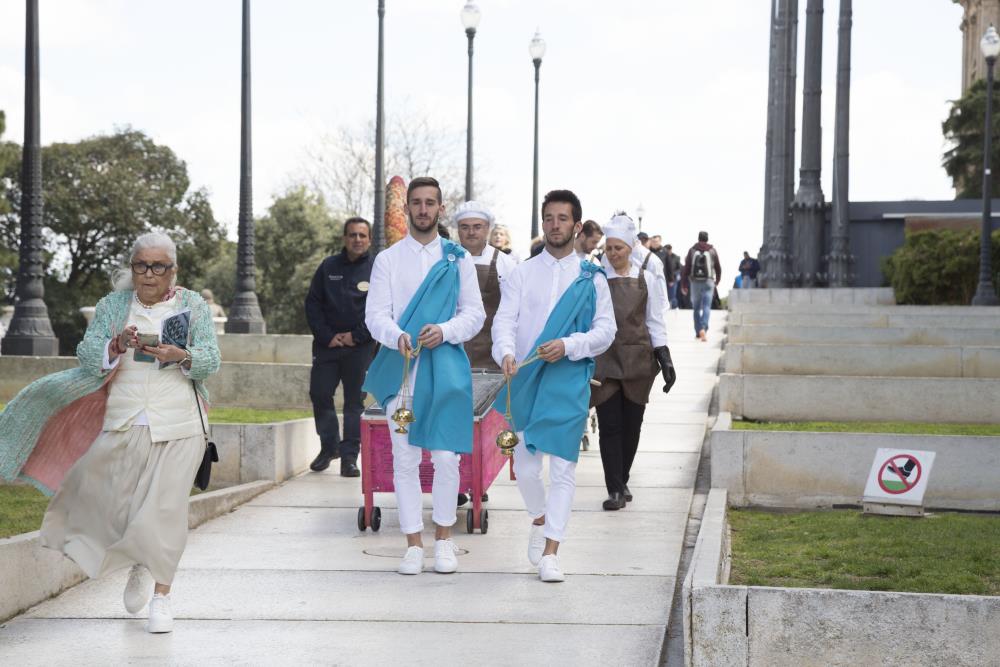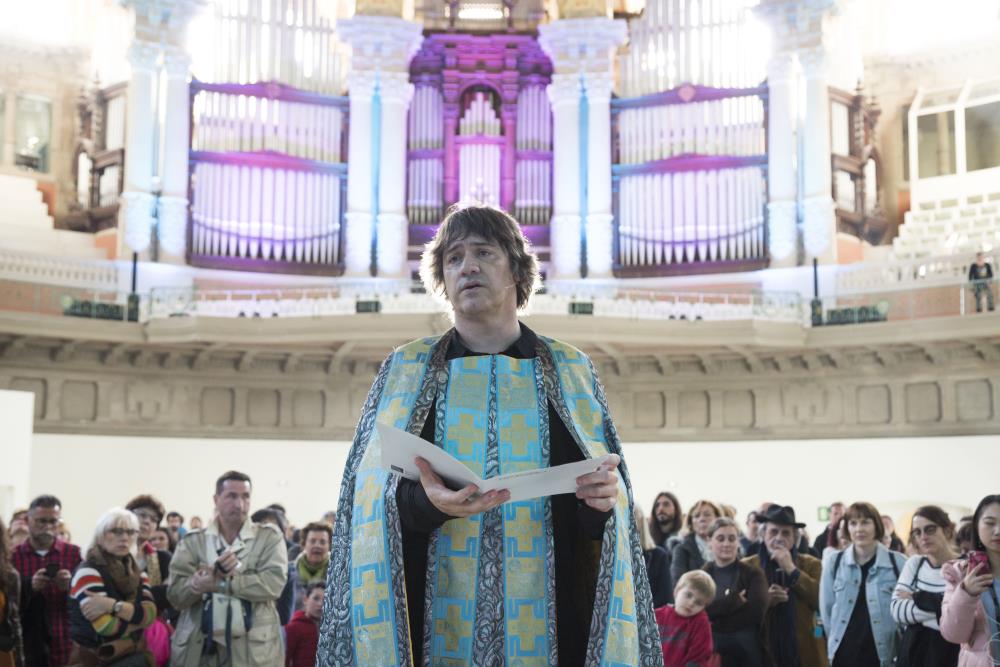Lluís Alabern
Peccata Mundi is an artistic ceremony-performance-installation, thought up by Antoni Miralda (Velázquez Awards for Plastic Arts, 2018) based around a huge bedspread which reproduces the Agnus Dei from the Romanesque mural painting of Sant Climent de Taüll.
This enormous tapestry was created in 1989 as a wedding present for the symbolic marriage that united the Statue of Liberty of New York, with the Monument of Columbus of Barcelona (Honeymoon Project, 1986-1992). The piece, of 18m x 15 metres, was once again exhibited to the public in the Sala Oval on the occasion of the exhibition Agnus dei. Romanesque art and the artists of the 20th century (1995). It is therefore almost 25 years since the great bedspread was last seen, in that exhibition organised to celebrate the opening of the Romanesque Art Collection.
Peccata Mundi is an opportunity to see this colossal piece once again. Antoni Miralda, fascinated by the Apocalyptic Lamb, due to its shades of blue, for the seven eyes that from the apse of Sant Climent de Taüll absolve the sinners of the world, it has become the master of ceremonies of a performance-installation that has illuminated the Sala Oval of the Museu Nacional for four days.

Musical installation during the days prior to the culinary performance of Saturday 6th April, Peccata Mundi counts on the symbolic resurrection of the organ of the Sala Oval (hand in hand with the music of J.S.Bach performed by Juan de la Rubia on the Walcker organo of the Palau de la Música Catalana) and the illumination of the tubes in shades of turquoise. The “resuscitated” organ of the Sala Oval, dialogue with the overwhelming presence of the Agnus Dei tapestry, and seven large-sized tables reproducing the eyes of the mystical figure.

During Saturday 6th, Antoni Miralda orchestrates a major ceremony thought up for more than 400 people, in which the Mystic Lamb is once again sacrificed to expunge the sins of humanity, in an unforgettable ceremony, a gift to the City that was once home to the marriage between Liberty and Columbus.
The Ceremony

Saturday. From the early hours of the morning a lamb is cooked on the embers in the main façade of the Museu Nacional. Two twin altar boys bless the cooking with incense burners. The public starts entering. At 12 o’clock, in front of the murals of Sant Climent de Taüll, Antoni Miralda distributes the Aerinita cocktail, forty turquoise-coloured drink potions served in test tubes, the blood of the Lamb of the Apocalypse, and carries out a symbolic offering under the attentive look of the seven eyes. Aerinita is a subtle drink designed by Joan Serinyana, with seven ingredients, from the rennet of the xisqueta sheep, the last autochthonous race of the Catalan Pyrenees.

Photo: Marta Mérida 
Photo: Marta Mérida
At 12:30pm, the ceremony-performance moves to the Sala Oval. Two formations from the Fundació Conservatori Liceu, a wind septet and a brass septet, perform the Agnus Dei by Palestrina and the Agnus Dei from the B minor Mass by Johann Sebastian Bach, while putting up the imposing tapestry.

Afterwards, all the participating public, acolytes of the ceremony-performance, are invited to a medieval-inspired tasting menu designed by the FoodCultura team, directed by Montse Guillen; Aerinita cocktail, cold almond soup, mortar of kid with seven sauces from the medieval recipe book, and Piment dessert (bread with wine and sugar).

At 5 o’clock in the afternoon, the countertenor Jordi Domènech accompanied on the organ by Dani Espasa, moves us all with pieces by G.Ligeti, and a new Agnus Dei, that of the Missa Lux et Origo. Jordi Domènech, magnificently attired in a ceremonial robe, approaches the mystic curtain and, holding his gaze to the seven eyes of the Mystic Lamb, sings the De die Novíssimo, very moving for all of us.

The countertenor Jordi Domènech 
The countertenor Jordi Domènech
“Agnus Dei qui tollis peccata mundi, miserere nobis”
The Lamb of the Apocalypse Agnus Dei by Miralda, cyclopean tapestry, is a centerpiece of the collections of the Museu Nacional d’Art de Catalunya. A work in which everything is excess, and in which countless stories are crossed. Inspired by the “founding piece” of the National Museum, the apse of Sant Climent de Taúll. But also connected with the recent history of the city and the country, a work that links this corner of Europe with the Ibero-American communities, and whose magnitude finally fills with major art a space that has always resisted us, the also phenomenal Sala Oval. Nowadays, many people request that the Agnus Dei de Miralda remains forever installed in the Sala Oval or, at least, we look for a ritual excuse, to return it to the visitors with a certain regularity.
Mediació i Programació Cultural







